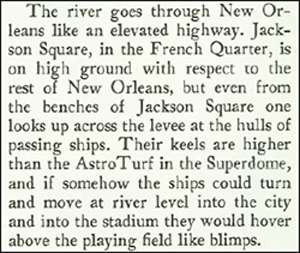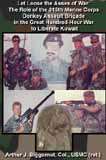William Sargent, Letting Mississippi Run its Natural Course Could Save New Orleans from Hurricanes, Christian Science Monitor, May 19, 2011.Sargent points out that, yes, it would have been good for the Louisiana coast to let the Mississippi River run wild, keep depositing sediment in the delta to build up new coastal wetlands, and shift course every five thousand years, as it has done throughout its history, and which it would have done at some point by now if man hadn’t intervened. But Sargent gets several points wrong and glosses over several important issues. Wrong is his statement comparing a possible breach of the river’s levees with Katrina’s flooding:
The full force of the Mississippi would fill up the underwater bowl in which New Orleans lies with far more force and water than filled the city when Lake Pontchetrain burst it’s levees after Katrina.First, the lake is spelled “Pontchartrain” and its levees did NOT burst after Katrina; it was the floodwalls along the various canals in the city that burst. In fact, no levees “burst” during Katrina: some were overtopped, but it was the collapsing of the floodwalls that caused the worst of the flooding in New Orleans.
And he glosses over the drawbacks of letting the Mississippi flow down the Atchafalaya basin, as it would have done if the Army Corps of Engineers hadn’t tamed it with the Morganza Spillway and others structures along the river in that same area. Yes, all that sediment that the Mississippi washes down from the middle third or so of the country could now be building new wetlands along the middle of the Louisiana coast, but not if we wanted to keep it navigable. The reason we’re losing wetlands south of New Orleans is that the river has been engineered to not silt up and so all the sediment is going out into the Gulf instead of building up new land along the mouth of the river.
But Sargent’s most egregious offense is to rip off a memorable image from John McPhee’s 1987 New Yorker February 23, 1987 article, The Control of Nature (Atchafalaya). Sargent may have “consulted” this article in his research, as it is one of the standard works on the history of controlling the Mississippi, but he crosses the line with the second of these two paragraphs:
The Mississippi River is impressive. In New Orleans, it is straitjacketed between 20-foot high levees, and the river itself is over 150 feet deep. When President Bush finally went down to New Orleans to address the situation after hurricane Katrina, he stood on Jackson Square, facing the river that flowed by, 20 feet over his head.Besides not capitalizing “Superdome” (a minor oversight, unless you’re a Saints Fan!!! Its “THE Superdome”, not “a superdome”, like there are a couple of dozen of them scattered around the country), the image of ships hovering over the playing field is clearly lifted from this paragraph in McPhee’s article:
You could see the superstructure of supertankers and hear the quiet thrumming of their engines as they cruised by in front of him. If the ships could have cruised over the nearby superdome they would have hovered in the air 10 feet above centerfield. It would have been an impressive photo-op, indeed, if the levees had decided to break during the presidential address.

Here’s the two key sentences, side by side:
Sargent:
If the ships could have cruised over the nearby superdome they would have hovered in the air 10 feet above centerfield.McPhee:
[I]f somehow the ships could turn and move at river level into the city and into the stadium they would hover above the playing field like blimps.I’ve been reading a whole lot about plagiarism for an article I’m working on, and all the definitions for plagiarism include something along the lines of “using the words or ideas of another person as if they were your own.” And that, clearly, is what Sargent has done here. Oh, and “centerfield” is part of the field where baseball is played. In football commentators generally call the area around the fifty-yard line “mid-field.”




No comments:
Post a Comment